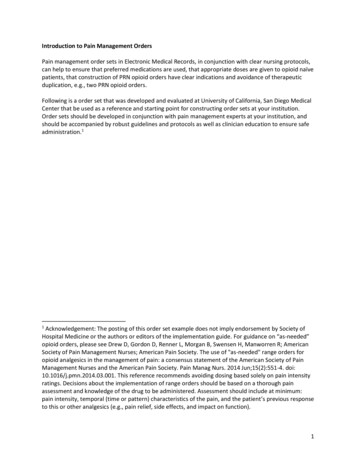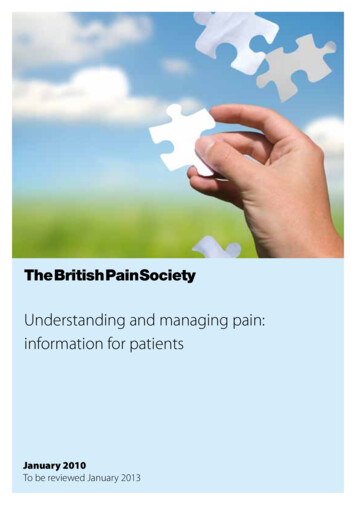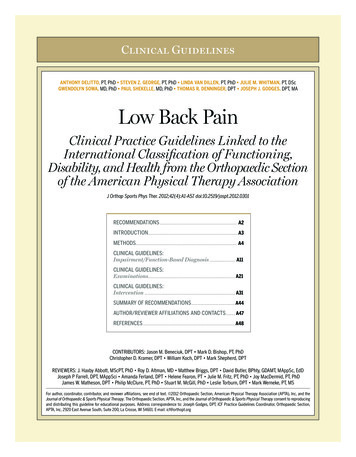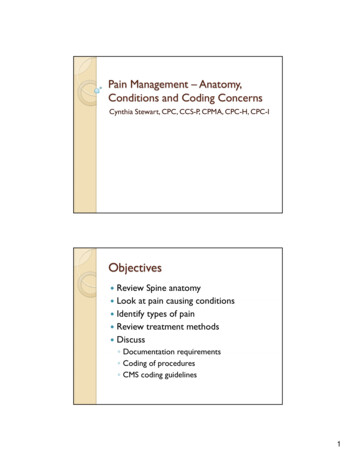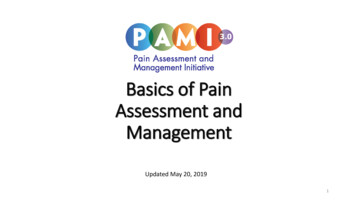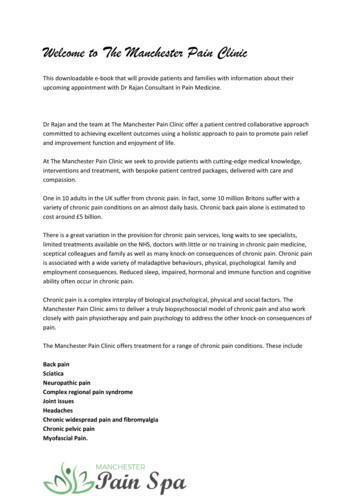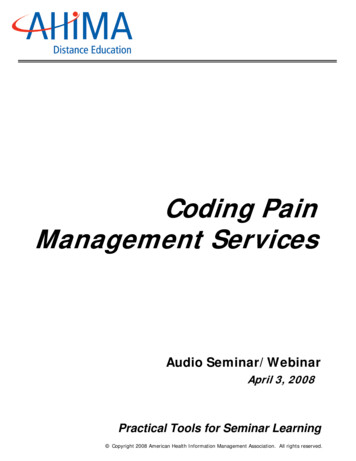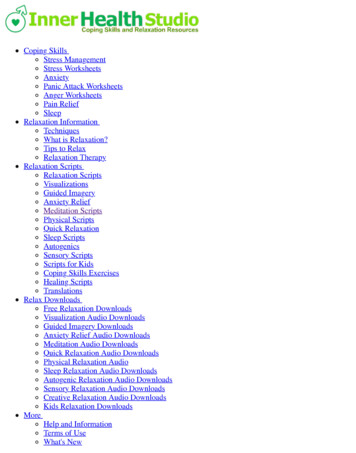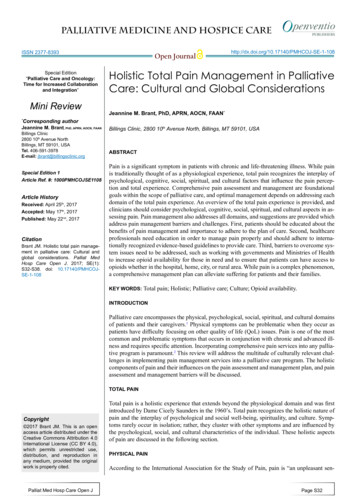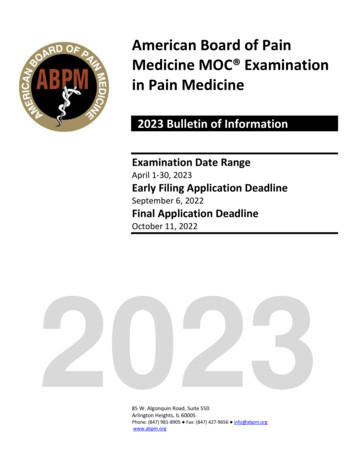
Transcription
American Board of PainMedicine MOC Examinationin Pain Medicine2023 Bulletin of InformationExamination Date RangeApril 1-30, 2023Early Filing Application DeadlineSeptember 6, 2022Final Application DeadlineOctober 11, 2022202385 W. Algonquin Road, Suite 550Arlington Heights, IL 60005Phone: (847) 981-8905 Fax: (847) 427-9656 info@abpm.orgwww.abpm.org
Definition of Pain MedicineThe specialty of Pain Medicine is a discipline within the field of medicine that is concerned with the prevention of pain,and the evaluation, treatment, and rehabilitation of persons in pain. Some conditions may have pain and associatedsymptoms arising from a discrete cause, such as postoperative pain or pain associated with a malignancy, or may beconditions in which pain constitutes the primary problem, such as neuropathic pains or headaches.Pain Medicine specialists use a broad-based approach to treat all pain disorders, ranging from pain as a symptom ofdisease to pain as the primary disease. The pain physician serves as a consultant to other physicians but is often theprincipal treating physician (as distinguished from the primary care physician) and may provide care at various levels, suchas treating the patient directly, prescribing medication, prescribing rehabilitative services, performing pain-relievingprocedures, counseling patients and families, directing a multidisciplinary team, coordinating care with other health careprofessionals and providing consultative services to public and private agencies pursuant to optimal health care deliveryto the patient suffering with pain. The objective of the pain physician is to provide quality care to the patient sufferingwith pain. The pain physician may work in a variety of settings and is competent to treat the entire range of painencountered in delivery of quality health care.Pain Medicine specialists typically formulate comprehensive treatment plans, which consider the patients’ culturalcontexts, as well as the special needs of the pediatric and geriatric populations. Evaluation techniques includeinterpretation of historical data; review of previous laboratory, imaging, and electrodiagnostic studies; assessment ofbehavioral, social, occupational, and avocational issues; and interview and examination of the patient by the painspecialist.ABPM Board of DirectorsPresidentKenneth Finn, MDColorado Springs, COPresident-ElectThomas Haley, DOPottstown, PASecretary-TreasurerNorman Marcus, MDNew York, NYImmediate Past PresidentScott J. Davidoff, MDKing of Prussia, PAExamination Council DirectorGregory Vassilev, MDBeverly Hills, CACredentials Council DirectorJonathan M. Hirsch, MDBrooklyn, NYDirectorsBradford Bobrin, MDCinnaminson, NJJ. David Haddox, DDS, MDAnna Maria, FLAnn E. Hansen, DVM, MDKetchum, IDWilliam Jangro, MDPhiladelphia, PAZachary McCormick, MDSalt Lake City, UTMedhat Mikhael, MDLong Beach, CASteven P. Stanos, Jr., DOSeattle, WACarlos O. Viesca, MDEl Paso, TXAmerican Board of Pain MedicineThe American Board of Pain Medicine (ABPM) was founded in 1991 as the American College of Pain Medicine. In 1994, thename was changed to the American Board of Pain Medicine to reflect the nomenclature of other medical specialty boards.MissionThe mission of the American Board of Pain Medicine is to serve the public by improving the quality and availability of painmedicine services.2
American Board of Pain Medicine Glossary of TermsThroughout publications from ABPM, certain terms with specific meanings are employed. To better understand theintentions of the ABPM, some of these terms are defined below:ACGME: The Accreditation Council on Graduate MedicalEducation is a private, not-for-profit council thatevaluates and accredits medical residency programs inthe United States. The ACGME's member organizationsare the American Board of Medical Specialties, theAmerican Hospital Association, the American MedicalAssociation, the Association of American MedicalColleges, and the Council of Medical Specialty Societies.Prescribing) offered by the ABPM. The successfulprogression of status for Certification or Maintenance ofCertification is Applicant, Candidate, Examinee, andDiplomate or Certificant, as appropriate.Application Package: An Application Package comprisesthe Examination Application itself and any requiredaccompanying materials, such as copies of licenses, anyrequired explanatory narratives, etc.ABMS: The American Board of Medical Specialties is anot-for-profit organization comprising 24 medicalspecialty Member Boards, whose primary function is toassist its Member Boards in developing andimplementing educational and professional standards toevaluate and certify physician specialists.Board-eligible: ABPM does not use the term “boardeligible.” An individual may progress through thecertification stages as an applicant, candidate, examinee,and finally, a Diplomate.Candidate: An Applicant who the ABPM CredentialsCommittee has deemed as meeting the eligibility criteriafor an examination offered by the ABPM.Adverse Action: An Adverse Action is any measure takenby a governmental entity that affects a practitioner’slicense to practice a health profession or their authorityto use controlled substances in clinical care or research.Adverse Actions include, but are not limited, to thefollowing: 1) limiting the scope of a practitioner’s licenseto practice, such as restriction a) on the prescribing ofspecific drugs or classes of drugs, b) on the performanceof specific procedures, c) on the examination of specifictypes of patients (eg, age or gender), d) on engaging inspecific types of therapy, or e) of practice to certainsettings; 2) imposing special provisions or obligations,such as requiring a) a practice monitor, b) remedialtraining or education, c) completion of an educationalcourse in medical documentation, prescribing, ethics, orprofessional behavior (eg, remediation for boundaryviolations or disruptive behavior), d) a medical,psychological, substance abuse, or psychiatricevaluation, or e) counseling of any kind; or 3) disciplinaryactions, such as a) probation, b) suspension, c)revocation, or d) denial, or e) issuance of a letter ofconcern, guidance, censure, or reprimand, regardless ofwhether the action is or may be reportable to theNational Practitioner Data Bank or any other officiallysanctioned or required registry.Category I Continuing Medical Education: ContinuingEducation for physicians that is offered by an accreditedCME provider recognized by the American MedicalAssociation as counting toward Category I of thePhysician’s Recognition Award or offered in another CMEsystem recognized by AMA (see: ontinuingmedical-education.page). Accredited CME providersinclude all those that are accredited by the AccreditationCouncil on Continuing Medical Education (ACCME) andthose State medical societies recognized by the ACCME.Credit from other CME systems includes AAFP prescribedcredit and ACOG formal learning cognates booklet.pdf)Certificant: A licensed health professional who hassuccessfully completed a Certificate of Knowledgeexamination offered by ABPM, to whom a Certificate ofKnowledge has been issued by ABPM, and who meets allcurrent, applicable eligibility criteria.Certificate of Knowledge: A document issued by ABPMto a licensed health care professional, or a studentenrolled in a course of study leading to qualification forlicensure as a health care professional, whichacknowledges successful completion of an examinationApplicant: A licensed health professionals who hasinitiated the application process for Certification in PainMedicine, Maintenance of Certification in Pain Medicine,or a Certificate of Knowledge (eg, Safe Opioid3
American Board of Pain Medicine Glossary of Termsthat tests knowledge of a specific subset of PainMedicine.Primary Residency: Any residency training program that(a) provides a structured educational experiencedesigned to conform to the program requirements of aparticular medical specialty, is (b) accredited by theACGME, that (c) requires successful completion ofallopathic or osteopathic undergraduate medical trainingprogram as a prerequisite for matriculation, and is (d)designed to prepare physicians to be eligible for generalcertification by an ABMS member board. Examples ofprimary residencies include anesthesiology, physicalmedicine and rehabilitation, psychiatry, neurology, andneurological surgery.Certification: A process to provide assurance to thepublic that an ABPM Diplomate has successfullycompleted an approved educational program and anevaluation, including an examination process designedto assess the requisite knowledge to practice highquality clinical pain medicine.Clinical Practice of Pain Medicine: The delivery of directpain care to patients by a physician who has successfullycompleted a Primary Residency. Chart review, basicscience research, administrative work, providing expertopinion for administrative or litigation purposes, andother non-clinical activities are not considered theClinical Practice of Pain Medicine.Residency Training Program: Any graduate or postgraduate medical education program accredited byACGME that provides a structured educationalexperience designed to conform to the programrequirements of a particular specialty/subspecialty, thesatisfactory completion of which is an eligibilityrequirement for ABMS board certification. Participantsin an ACGME-accredited fellowship, sometimes referredto as a subspecialty residency, are included in the term“residency training program.” Fellowship programsinclude only those programs of graduate medicaleducation accredited by the ACGME that are beyond thePrimary Residency requirements for eligibility for the firstboard certification in a particular medical specialty (eg,the primary ACGME-accredited residency trainingprogram is anesthesiology and the ACGME-accreditedfellowship is in pain medicine)Diplomate: A physician who has successfully completedeither a Certification in Pain Medicine or a Maintenanceof Certification in Pain Medicine examination offered byABPM, to whom a diploma documenting Certification inPain Medicine has been issued by ABPM, and who meetsall current, applicable eligibility criteria. (NB: Oftenconfused with “diplomate” (one who holds a diploma orcertificate) is “diplomat” (eg, a consular official). ABPMdoes not use the term “diplomat” to refer to physicianscurrently certified as pain medicine specialists by ABPM.)Examination Application: A form supplied by ABPM tobe completed by an Applicant as part of the ApplicationPackage.Unrestricted:An Unrestricted license to practice a health profession oran Unrestricted authorization to use controlledsubstances in the clinical care of patients or in researchmeans that there is no Adverse Action affecting thepractitioner’s license or controlled-substancesauthorization.Examinee: A Candidate who initiates an examinationoffered by the ABPM.Fellowship: Any graduate medical education trainingprogram that (a) requires successful completion of aPrimary Residency as a prerequisite and that (b) isaccredited by the ACGME. Fellowship includessubspecialty residency training programs that meetcriteria (a) and (b). Examples of fellowship programsinclude pain medicine and hospice/palliative caremedicine.Any action taken by a licensee to avoid or in anticipationof an Adverse Action precludes a license or a controlledsubstances authorization from being Unrestricted in thesense that the term is used by the ABPM.Maintenance of Certification: A process to provideassurance to the public that an ABPM Diplomate, byvirtue of an application to determine continued eligibilityand successful completion of an examination process,continues to possess the requisite knowledge to practicehigh-quality pain medicine.4
American Board of Pain Medicine Glossary of Termsthe application materials are incomplete and additionalinformation, clarification, or documentation is requiredto constitute an Application Package.PLEASE READ ALL INSTRUCTIONSCAREFULLY BEFORE ENTERING ANYINFORMATION ON THE APPLICATION.All written hard-copy correspondence from ABPM will besent via United States Postal Service to the mailingaddress indicated on the application form, which will bethe Applicant’s address of record.An Application Package comprises the ExaminationApplication, the required supporting materials, and theapplicable fees. Supporting material required by ABPMincludes, but may not be limited to, photocopies oflicense(s) to practice medicine, photocopies of U.S. DEAregistration(s), and Referee Checklists. For a submission tobe deemed an Application Package, each componentmust be complete, accurate, legible, clear, not misleading,and unambiguous. For example, if a submission includedan Examination Application that included unclear orambiguous or internally inconsistent information, thatsubmission would constitute an Application Package. TheCredentials Committee reserves the right to rejectsubmissions from an Applicants that do not constitute anApplication Package, even if the component parts aresubmitted and reviewed by members of the Committee.At its sole discretion, the Credentials Committee mayallow an Applicant one chance to cure a submissionfound not to constitute an Application Package followingCommittee review.The Applicant must also provide either a valid emailaddress or a telephone number where s/he can becontacted. It is recommended that the Applicant alsoinclude the name of another contact person if only atelephone number is provided.Contact Information Changes: It is the responsibility ofthe Applicant to notify the ABPM office immediately ofany changes in contact information that take effectduring consideration for the examination process.Notification should be sent by email at info@abpm.org.Name Changes: Once application materials aresubmitted, an Applicant will be able to change theirname of record with ABPM only by a written requestthat is accompanied by acceptable legal documentationregarding the name change.Only Application Packages that are submitted andcomplete on or before Tuesday, October 11, 2022 will beaccepted for consideration by ABPM. The applicationportal will close at 12:00 AM on Wednesday, October 12,2022. Applications that were begun but not completeand submitted by 11:59 PM Central time on October 11,2022 will not be considered.Filing FeesThe filing fee comprises three distinct fees: theapplication fee, the test-appointment fee and thenonrefundable processing fee. The test-appointmentfee is transferred by ABPM to the test administrator as apass-through and is NOT an additional fee to ABPM. Thefiling fee is a required component of the ApplicationPackage. Payment of the filing fee must be providedwithin the online application portal. Applications withinthe portal will not be eligible for submission withoutpayment.The ABPM Credential Committee will only reviewcomplete Application Packages. Applications lackingrequired information will not be considered.Applicants bear the sole responsibility for ensuring thattheir Application Packages are complete. Since somesupporting documentation required by ABPM is fromthird parties, Applicants are strongly encouraged to allowample time for those third parties to complete and submitrequired supporting documentation to them foruploading into the application portal.Early Filing Application FeeFinal Filing Application FeeNonrefundable Processing FeeTest-Appointment Fee 950 1,150 500 130Total Early Filing Fee 1,580Application Packages qualify for the early file fee only ifthe application is submitted on or before 11:59 PM onSeptember 6, 2022.After an initial review of the Application Package byABPM staff, each Applicant will receive a notice from theABPM office indicating that their Application Package isready for review by the Credentials Committee or that5
InstructionsTotal Final Filing Fee 1,780Application Packages will be considered only if theapplication is submitted on or before 11:59 PM onOctober 11, 2022.The nonrefundable processing fee is incurredimmediately upon receipt of any the applicationmaterials by ABPM, regardless of eligibility outcome.The remainder of the filing fee will be refunded if theApplicant: (a) does not meet the eligibility requirements,(b) does not submit the requisite information toconstitute an Application Package complete, accurate,legible and unambiguous application in a timely fashionby the applicable deadline, or (c) requests, in writing, tohave their application withdrawn from consideration forthe Certification Examination process.Withdrawing an ApplicationOnce submitted, it is NOT possible to transfer anyapplication materials to a later Examination.An application must be withdrawn in writing and mustbe initiated by the Applicant. Requests to withdrawapplications may be emailed to info@abpm.org.RefundsRegardless of its action on any application, ABPM willretain a 500 nonrefundable processing fee and willrequire Applicants to pay all fees and meet eligibilitycriteria applicable at the time of any future application.If for any reason a Candidate does not sit for anExamination for which he or she is eligible, they mayrequest a refund of the remainder of the filing fee, lessthe 500 nonrefundable processing fee. The requestmust be in writing and must either be a) received byABPM electronically (email or facsimile) or b)postmarked not later than 30 calendar days followingthe end of that Examination Date Range.Candidates may also be responsible for any testingappointment fees.Requests for partial refund of the filing fee postmarkedor received electronically (by facsimile or email) 31calendar days following the end of the Examination DateRange will not be considered.6
American Board of Pain Medicine MOC Eligibility RequirementsThe eligibility requirements for the ABPM Certification Examination in Pain Medicine are asfollows:To be Board Certified by the ABPM, an Applicant musthave satisfactorily completed an ACGME-accreditedresidency training program that included identifiabletraining in the specialty of Pain Medicine. Applicants,Candidates and Examinees must hold a current and validcertification by an ABMS member board.REQUIREMENT 1—LICENSURE AND CONTROLLEDSUBSTANCES AUTHORIZATIONApplicants, Candidates, and Examinees must have atleast one license to practice allopathic or osteopathicmedicine that is current, valid, unrestricted, and free ofany disciplinary encumbrances. This license must beissued by (a) one of the States of the United States ofAmerica, its Territories, or Commonwealths, (b) a branchof the United States Uniformed Services, or (c) one ofthe Provinces or Territories of Canada. Further, everymedical license the applicant holds must be free ofrestrictions or encumbrances related to disciplinaryaction. Applicants, Candidates, and Examinees have anaffirmative duty to inform ABPM of any status change inlicensure or any other action regarding licensure, exceptroutine renewals. (Please review the definitions ofApplicant, Candidate, and Examinee in this Bulletin.)REQUIREMENT 3—PRACTICE PERFORMANCE ANDADHERENCE TO ETHICAL AND PROFESSIONALSTANDARDSAt the time of application Applicant must be engaged inthe Clinical Practice of Pain Medicine, on a substantialbasis.An Applicant must not have engaged in conduct which,in the judgment of the Board, (a) reflects unethicalactivity related to the practice of medicine, and (b) castssignificant doubt on the Applicant’s ability to practicepain medicine in the best interest of patients.In addition to at least one license to practice allopathicor osteopathic medicine, U.S. Applicants, Candidates,and Examinees must have a current, valid, andunrestricted registration with the U.S. Drug EnforcementAdministration (DEA) to prescribe, dispense, andadminister narcotic controlled substances and a current,valid, and unrestricted authorization to prescribe,dispense, and administer narcotic controlled substanceswith the controlled substances authority in everyjurisdiction(s) in which they are licensed to practicemedicine, where required by that jurisdiction. CanadianApplicants, Candidates, and Examinees must have thecorresponding authorization to prescribe, dispense, andadminister controlled substances. Further, every DEAregistration and controlled substances authorization theapplicant holds must be free of restrictions andencumbrances.To fulfill this requirement, Applicants must provideevidence of ethical and competent practice of painmedicine during the ten-year (10) period precedingsubmission of the application to sit for the AmericanBoard of Pain Medicine MOC examination.Applicants must submit a minimum of two (2) RefereeChecklists from physicians licensed to practice allopathicor osteopathic medicine, who can accurately and honestlyattest to the current nature and scope of the applicant’spractice in pain medicine.Included in the application portal is a link to the RefereeChecklist. Please provide one form to eachrecommending physician.REQUIREMENT 2—ACCREDITATION COUNCIL ONGRADUATE MEDICAL EDUCATION (ACGME)ACCREDITED TRAINING AND AMERICAN BOARD OFMEDICALSPECIALTIES(ABMS)BOARDCERTIFICATIONOnly one (1) checklist from a physician who practiceswithin the applicant’s clinic, practice, group, or functionalarea (eg, department, division) will be considered. Thesecond checklist should come from any physician outsidethe applicant’s practice who can attest to the nature ofhis or her current practice. The following are notconsidered eligible as Referees: trainees, employees,relatives, or spouses of the Applicant, physicians who are(or have been) related by marriage (separation or divorce7
American Board of Pain Medicine MOC Eligibility Requirementsnotwithstanding), civil union, cohabitation, or by otherfamilial means, non-physicians, and physicians who werefamiliar with the Applicant’s practice at some time in thepast (eg, colleagues from training programs), but lackfamiliarity with the Applicants current practice.will be issued certificates as specialists in the field of painmedicine and designated as ABPM Diplomates. A list ofcurrently certified ABPM Diplomates is available atwww.abpm.org.ABPM Goals and Objectives1.To establish Pain Medicine as a primary medicalspecialty. Objectives to meet this goal include:If an applicant practices in a multispecialty clinic, practice,group, or corporation comprising at least 50 physicians,such as a teaching hospital or large clinic, one checklistcan be from a physician who practices within theapplicant’s functional area (eg, department, division) andthe second may be either from a physician practicing in afunctional area that is distinctly different from that of theapplicant, or from a physician practicing outside theapplicant’s clinic, practice, group or corporation who canattest to the applicant’s current practice of pain medicine. It is the responsibility of the Applicant to provide theReferee Checklists to their referring physicians andupload them through the application portal by theestablished deadline. REQUIREMENT 4—CONTINUING MEDICALEDUCATION (CME)Within the 10-year period ending on the FinalApplication Deadline, Applicants must have completed aminimum of 300 hours of Category I Continuing MedicalEducation (CME) approved by the Accreditation Councilon Continuing Medical Education (ACCME), or Canadiancertified CME (MAINPRO, MOCOMP), recognized asequivalent by the ABPM Credentials Committee. At least150 of these hours must be instruction in pain medicine.A minimum of 100 of the total hours must have beencompleted during the three years ending on the deadlinefor receipt of applications, with at least 50 of thosehours being instruction in pain medicine.Maintenance of a high- quality Certificationand Maintenance of Certification (MOC)process consistent with those of MemberBoards of the American Board of MedicalSpecialties.Collaboration with national organizations toadvance this goal.Promotion of ABPM Certification at the Statelevel, furthering recognition of ABPMcertification as a valued and respecteddesignation for physicians practicing painmedicine that is equivalent to ABMScertification.Promote ABPM Certification with the public,professional organizations, health careagencies, regulatory bodies, and payors as avalued and respected designation forphysicians practicing pain medicine that isequivalent to ABMS certification.2. To evaluate Candidates who voluntarily appear forexamination and to certify or recertify thoseCandidates as Diplomates in Pain Medicine who arequalified. Objectives to meet this goal include: American Board of Pain MedicineABPM is incorporated in the State of Illinois as a not-forprofit corporation and operates as an autonomousentity, independent of any other association, society, oracademy. This permits ABPM to maintain integrityconcerning its policy making on matters related tocertification.ABPM administers a psychometrically-developed andpractice-related examination in the field of painmedicine to qualified Examinees. Physicians who havesuccessfully completed the ABPM examination process8Determination of whether Applicants havereceived adequate preparation in accordancewith the educational standards established byABPM.
American Board of Pain Medicine MOC Overview Creation, maintenance and administration ofcomprehensive examinations to evaluate theknowledge and experience of Candidates.Issuance of certificates to those Examineesfound qualified under the stated requirementsof ABPM. 3. To maintain and improve the quality of graduatemedical education in the field of pain medicine bycollaborating with related organizations. Objectivesto meet this goal include: 4.Scope of Certification and Maintenance of CertificationThe eligibility requirements and examination materialsfor the ABPM certification program have beendeveloped based on substantial review and analysis ofthe current state of medical and scientific knowledge ofthe treatment of pain, as reflected in the medicalliterature. The ABPM Board of Directors and theExamination Council, with the assistance and advice ofprofessionals in relevant fields, have developed acertification program which encompasses both initialcertification and American Board of Pain MedicineMOC , and recognizes accepted levels of knowledge andexpertise in the profession, with the goal of improvingpatient care.Development of standards and requirements forgraduate medical education in Pain Medicine incollaboration with other concernedorganizations and entities.To provide information about the specialty ofpain medicine to the public. Objectives to meetthis goal include To establish the knowledge domain of the practice ofPain Medicine for certificationTo assess the knowledge of pain medicine physiciansin a psychometrically valid mannerTo encourage professional growth in the practice ofpain medicineTo formally recognize individuals who meet therequirements set forth by ABPM as DiplomatesTo serve the public by encouraging quality patientcare in the practice of pain medicineMaintenance of a publicly-accessible registryof physicians certified as Diplomates of theABPM.Provision of information to the public andconcerned entities about the rationale forcertification in pain medicine.Facilitation of discussion with the public,professional organizations, health careagencies and regulatory bodies regardingeducation, evaluation and certification ofpain medicine specialists.However, no certification program can guaranteecompetence or successful treatment to the public. Inaddition, given the rapid changes in medical knowledgeand the speed of scientific developments, ABPM cannotwarrant that either the certification or American Boardof Pain Medicine MOC examination materials will at alltimes reflect the most current state of the art.New developments are included in the examinationsonly after they have been accepted by practitioners ofpain medicine. Periodic practice analyses are conductedto ensure that the examinations continue to reflectactual practice conditions.The Purpose of Certification and Maintenance ofCertificationPain Medicine has emerged as a separate anddistinguishable specialty that is characterized by adistinct body of knowledge and a well-defined scope ofpractice, based on an infrastructure of scientific researchand education. Competence in the practice of PainMedicine requires advanced training, experience, andknowledge.ABPM welcomes constructive comments andsuggestions from the public and the profession. TheABPM Certification Program has been designed tocomply with the American Psychological Association’sjoint technical standards on testing and certificationindustry standards.ABPM is committed to certification of qualifiedphysicians in the field of Pain Medicine. The certificationprocess employs practice-based requirements againstwhich members of the profession can be assessed. Thepurposes of the ABPM Certification Program are asfollows:Test Development and AdministrationABPM retains Kryterion Global Testing Solutions, ofPhoenix, AZ, to provide assistance in the development ofthe annual certification examination. Kryterion is a9
American Board of Pain Medicine MOC Overviewconsulting firm specializing in the conceptualization,development, and implementation of professionalcertification programs. ABPM also utilizes online testdelivery services through Kryterion Test Centersnationwide.application, and any required accompanying documents,will be used by ABPM to determine eligibility to sit forthe examination.Processing the ApplicationABPM independently verifies information submitted inApplication Packages.About the ExaminationNational analyses of the practice of pain medicine havebeen undertaken to define the role of the pain medicinephysician and describe the responsibilities, tasks andtypes of knowledge necessary to practice the specialty.Practice analyses are conducted t
Residency Training Program: Any graduate or post-graduate medical education program accredited by ACGME that provides a structured educational experience designed to conform to the program requirements of a particular specialty/subspecialty, the satisfactory completion of which is an eligibility requirement for ABMS board certification .



